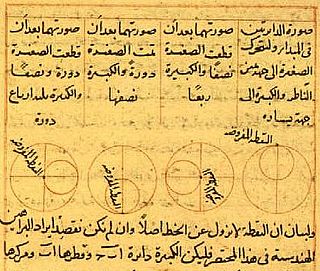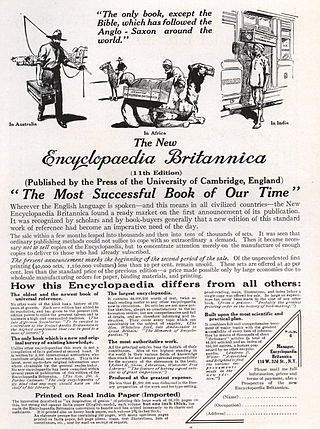Related Research Articles

The Encyclopædia Britannica is a general knowledge English-language encyclopaedia. It has been published by Encyclopædia Britannica, Inc. since 1768, although the company has changed ownership seven times. The encyclopaedia is maintained by about 100 full-time editors and more than 4,000 contributors. The 2010 version of the 15th edition, which spans 32 volumes and 32,640 pages, was the last printed edition. Since 2016, it has been published exclusively as an online encyclopaedia.

The Encyclopædia Britannica Eleventh Edition (1910–1911) is a 29-volume reference work, an edition of the Encyclopædia Britannica. It was developed during the encyclopaedia's transition from a British to an American publication. Some of its articles were written by the best-known scholars of the time. This edition of the encyclopaedia, containing 40,000 entries, has entered the public domain and is readily available on the Internet. Its use in modern scholarship and as a reliable source has been deemed problematic due to the outdated nature of some of its content. Modern scholars have deemed some articles as cultural artifacts of the 19th and early 20th centuries. Additionally, the 11th edition has retained considerable value as a time capsule of scientific and historical information, as well as scholarly attitudes of the era immediately preceding World War I.
Medical anthropology studies "human health and disease, health care systems, and biocultural adaptation". It views humans from multidimensional and ecological perspectives. It is one of the most highly developed areas of anthropology and applied anthropology, and is a subfield of social and cultural anthropology that examines the ways in which culture and society are organized around or influenced by issues of health, health care and related issues.

Science in the medieval Islamic world was the science developed and practised during the Islamic Golden Age under the Abbasid Caliphate of Baghdad, the Umayyads of Córdoba, the Abbadids of Seville, the Samanids, the Ziyarids and the Buyids in Persia and beyond, spanning the period roughly between 786 and 1258. Islamic scientific achievements encompassed a wide range of subject areas, especially astronomy, mathematics, and medicine. Other subjects of scientific inquiry included alchemy and chemistry, botany and agronomy, geography and cartography, ophthalmology, pharmacology, physics, and zoology.

Abū Marwān ‘Abd al-Malik ibn Zuhr, traditionally known by his Latinized name Avenzoar, was an Arab physician, surgeon, and poet. He was born at Seville in medieval Andalusia, was a contemporary of Averroes and Ibn Tufail, and was the most well-regarded physician of his era. He was particularly known for his emphasis on a more rational, empiric basis of medicine. His major work, Al-Taysīr fil-Mudāwāt wal-Tadbīr, was translated into Latin and Hebrew and was influential to the progress of surgery. He also improved surgical and medical knowledge by keying out several diseases and their treatments.

Rees's Cyclopædia, in full The Cyclopædia; or, Universal Dictionary of Arts, Sciences, and Literature was an important 19th-century British encyclopaedia edited by Rev. Abraham Rees (1743–1825), a Presbyterian minister and scholar who had edited previous editions of Chambers's Cyclopædia.
Munishvara or Munīśvara Viśvarūpa was an Indian mathematician who wrote several commentaries including one on astronomy, the Siddhanta Sarvabhauma (1646), which included descriptions of astronomical instruments such as the pratoda yantra. Another commentary he wrote was the Lilavativivruti. Very little is known about him other than that he came from a family of astronomers including his father Ranganatha who wrote a commentary called the Gụ̄hārthaprakaśa/Gūḍhārthaprakāśikā, a commentary on the Suryasiddhanta. His grandfather Ballala had his origins in Dadhigrama in Vidharba and had moved to Benares. Ballala had several sons who wrote commentaries on astronomy and mathematics. Munisvara's Siddhantasarvabhauma had the patronage of Shah Jahan like his paternal uncle Krishna Daivagna did. He was opposed to fellow mathematician Kamalakara, whose brother also wrote a critique of Munisvara's bhangi-vibhangi method for planetary motions. He was also opposed to the adoption of some mathematical ideas in spherical trigonometry from Arab scholars. An edition of his Siddhanta Sarvabhauma was published in the Princess of Wales Sarasvati Bhavana Granthamala series edited by Gopinath Kaviraj. Munisvara's book had twelve chapters in two parts. The second part had notes on astronomical instruments. He was a follower of Bhaskara II.

Aida Yasuaki also known as Aida Ammei, was a Japanese mathematician in the Edo period.
Sharaf al-Dīn al-Muẓaffar ibn Muḥammad ibn al-Muẓaffar al-Ṭūsī known more often as Sharaf al-Dīn al-Ṭūsī or Sharaf ad-Dīn aṭ-Ṭūsī, was an Iranian mathematician and astronomer of the Islamic Golden Age.
Abū Kāmil Shujāʿ ibn Aslam ibn Muḥammad Ibn Shujāʿ was a prominent Egyptian mathematician during the Islamic Golden Age. He is considered the first mathematician to systematically use and accept irrational numbers as solutions and coefficients to equations. His mathematical techniques were later adopted by Fibonacci, thus allowing Abu Kamil an important part in introducing algebra to Europe.

Paul Levinson is an American media theorist, novelist, singer-songwriter, and short story writer. He currently serves as professor of communications and media studies at Fordham University in New York City. His novels, short fiction, and non-fiction works have been translated into sixteen languages. He is frequently quoted in news articles and appears as a guest commentator on major news outlets.

The Encyclopaedia of Aboriginal Australia: Aboriginal and Torres Strait Islander history, society and culture, edited by David Horton, is an encyclopaedia published by the Aboriginal Studies Press at the Australian Institute of Aboriginal and Torres Strait Islander Studies (AIATSIS) in 1994 and available in two volumes or on CD-ROM covering all aspects of Indigenous Australians lives and world. There are 2000 entries and 1000 photographs, with the CD-ROM having 250 sound items and 40 videos.
An ijazah is a license authorizing its holder to transmit a certain text or subject, which is issued by someone already possessing such authority. It is particularly associated with transmission of Islamic religious knowledge. The license usually implies that the student has acquired this knowledge from the issuer of the ijaza through first-hand oral instruction, although this requirement came to be relaxed over time. An ijaza providing a chain of authorized transmitters going back to the original author often accompanied texts of hadith, fiqh and tafsir; but also appeared in mystical, historical, and philological works, as well as literary collections. While the ijaza is primarily associated with Sunni Islam, the concept also appears in the hadith traditions of Twelver Shia.

The Encyclopædia Britannica has been published continuously since 1768, appearing in fifteen official editions. Several editions have been amended with multi-volume "supplements", consisted of previous editions with added supplements or gone drastic re-organizations (15th). In recent years, digital versions of the Britannica have been developed, both online and on optical media. Since the early 1930s, the Britannica has developed several "spin-off" products to leverage its reputation as a reliable reference work and educational tool.
Ṣāʿid al-Andalusī, in full Abū al-Qāsim Ṣāʿid ibn Abū al-Walīd Aḥmad ibn Abd al-Raḥmān ibn Muḥammad ibn Ṣāʿid ibn ʿUthmān al-Taghlibi al-Qūrtūbi, was an Arab qadi of Toledo in al-Andalus, who wrote on the history of science, philosophy and thought. He was a mathematician and scientist with a special interest in astronomy and compiled a famous biographic encyclopedia of science that quickly became popular in the empire and the Islamic East.

Science and Civilisation in China (1954–present) is an ongoing series of books about the history of science and technology in China published by Cambridge University Press. It was initiated and edited by British historian Joseph Needham (1900–1995). Needham was a well-respected scientist before undertaking this encyclopedia and was even responsible for the "S" in UNESCO. To date there have been seven volumes in twenty-seven books. The series was on the Modern Library Board's 100 Best Nonfiction books of the 20th century. Needham's work was the first of its kind to praise Chinese scientific contributions and provide their history and connection to global knowledge in contrast to eurocentric historiography.
Eric Wayne Ehrmann is an American author who follows sports, politics and weapon of mass destruction issues in Latin America.
Helaine Selin is an American librarian, historian of science, author and the editor of several bestselling books.

Hard Choices: Climate Change in Canada is a non-fiction compilation book about climate change in Canada, edited by Harold Coward and Andrew J. Weaver. It was published in paperback format by Wilfrid Laurier University Press in 2004.
David Robert Horton is an Australian writer who has been described as a polymath, with qualifications and careers in science and the arts. He is known for his compilation of the work The Encyclopaedia of Aboriginal Australia: Aboriginal and Torres Strait Islander history, society and culture in 1994, and its accompanying map of Aboriginal groupings across Australia.